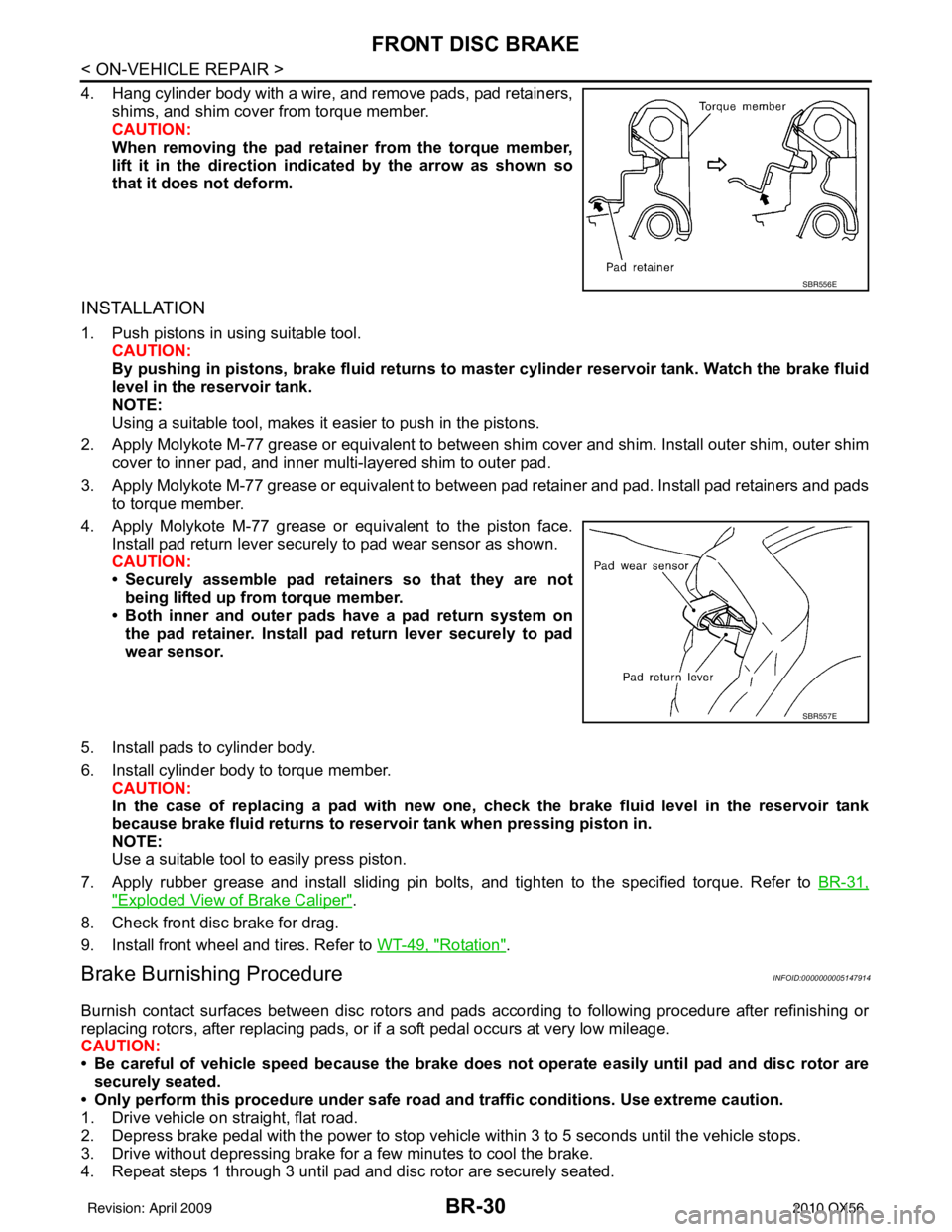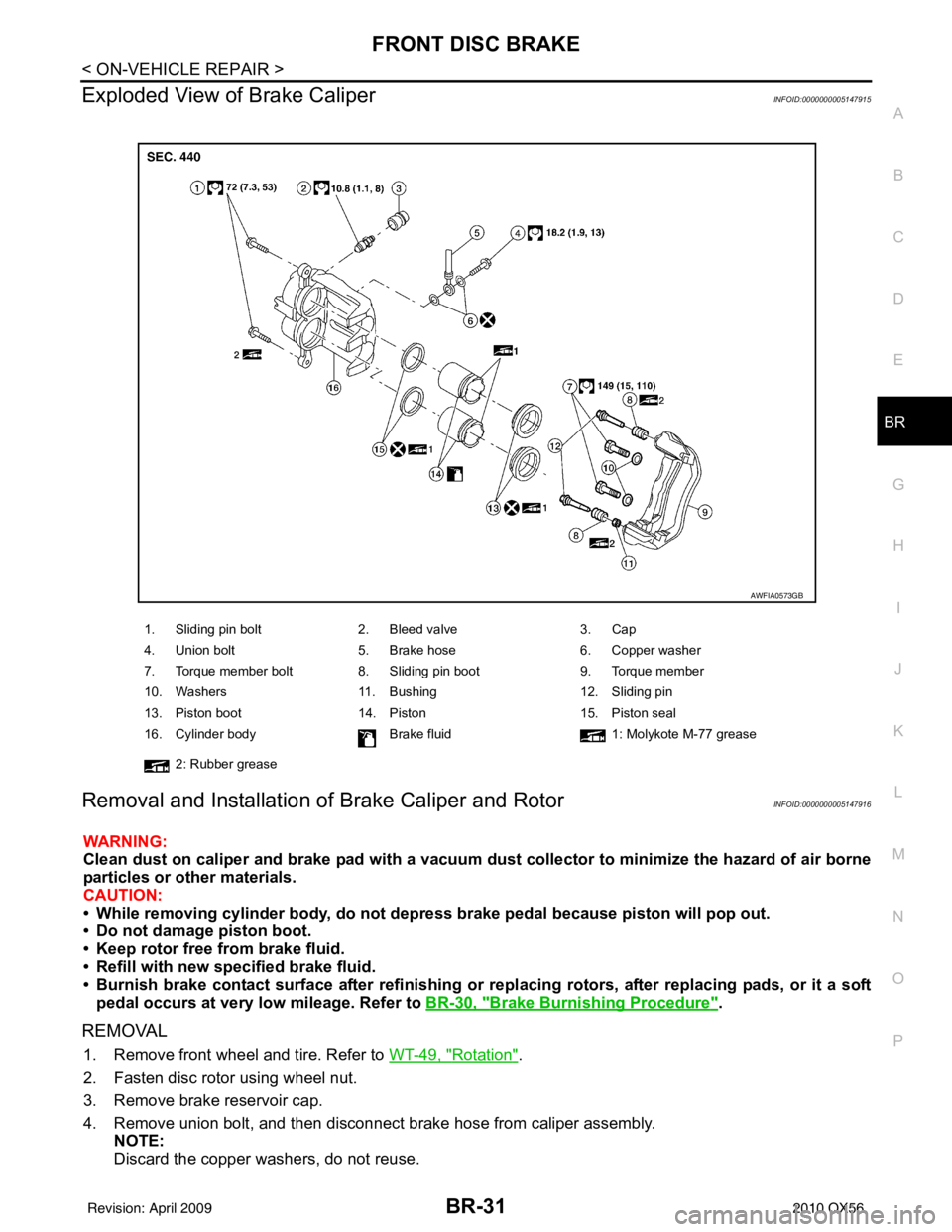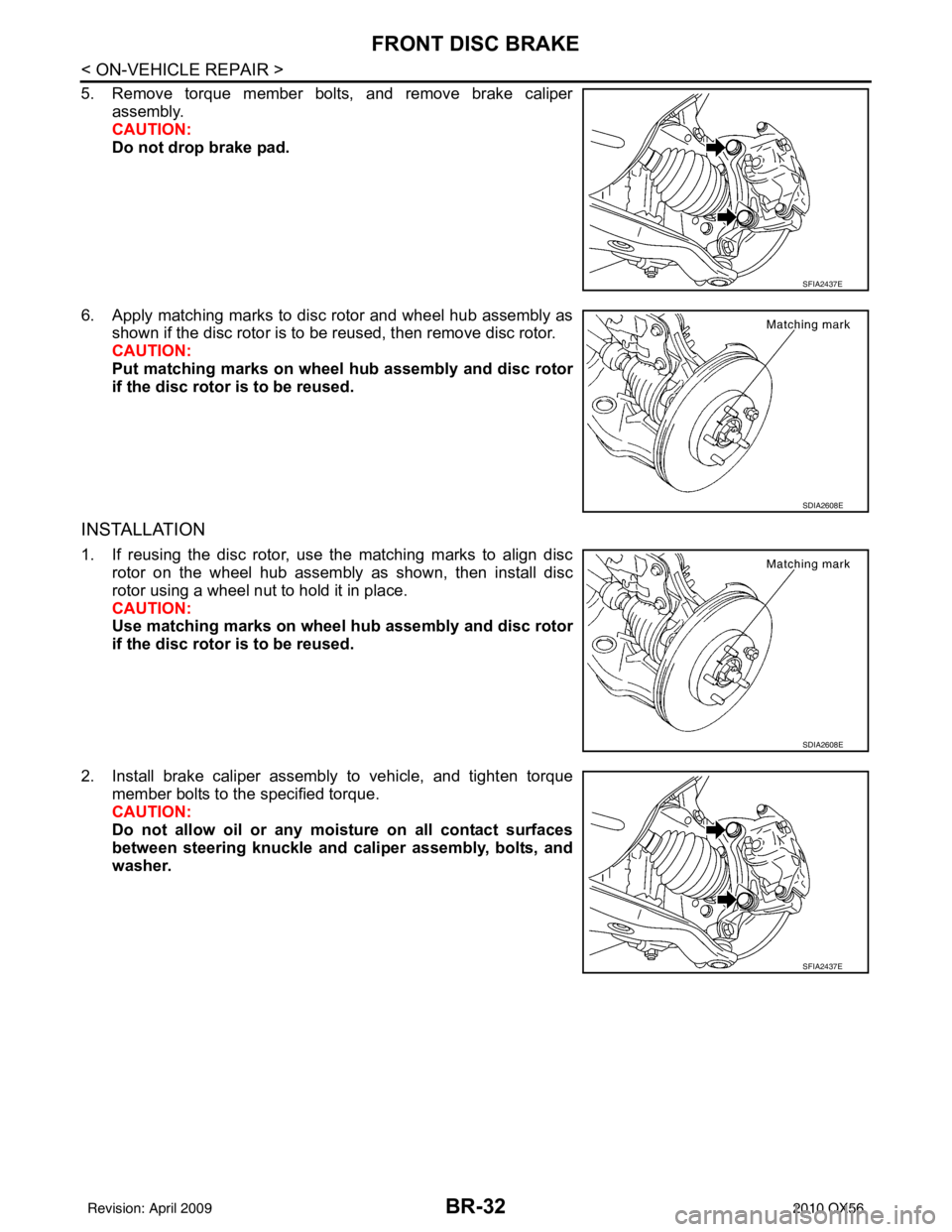brake rotor INFINITI QX56 2010 Factory User Guide
[x] Cancel search | Manufacturer: INFINITI, Model Year: 2010, Model line: QX56, Model: INFINITI QX56 2010Pages: 4210, PDF Size: 81.91 MB
Page 475 of 4210

BR-30
< ON-VEHICLE REPAIR >
FRONT DISC BRAKE
4. Hang cylinder body with a wire, and remove pads, pad retainers,shims, and shim cover from torque member.
CAUTION:
When removing the pad retainer from the torque member,
lift it in the direction indi cated by the arrow as shown so
that it does not deform.
INSTALLATION
1. Push pistons in using suitable tool.
CAUTION:
By pushing in pistons, brake fluid returns to m aster cylinder reservoir tank. Watch the brake fluid
level in the reservoir tank.
NOTE:
Using a suitable tool, makes it easier to push in the pistons.
2. Apply Molykote M-77 grease or equivalent to between shim cover and shim. Install outer shim, outer shim cover to inner pad, and inner multi-layered shim to outer pad.
3. Apply Molykote M-77 grease or equivalent to between pad retainer and pad. Install pad retainers and pads to torque member.
4. Apply Molykote M-77 grease or equivalent to the piston face. Install pad return lever securely to pad wear sensor as shown.
CAUTION:
• Securely assemble pad retainers so that they are not
being lifted up from torque member.
• Both inner and outer pads have a pad return system on
the pad retainer. Install pad return lever securely to pad
wear sensor.
5. Install pads to cylinder body.
6. Install cylinder body to torque member. CAUTION:
In the case of replacing a pad with new one, ch eck the brake fluid level in the reservoir tank
because brake fluid returns to reservoir tank when pressing piston in.
NOTE:
Use a suitable tool to easily press piston.
7. Apply rubber grease and install sliding pin bolts, and tighten to the specified torque. Refer to BR-31,
"Exploded View of Brake Caliper".
8. Check front disc brake for drag.
9. Install front wheel and tires. Refer to WT-49, "
Rotation".
Brake Burnishing ProcedureINFOID:0000000005147914
Burnish contact surfaces between disc rotors and pads according to following procedure after refinishing or
replacing rotors, after replacing pads, or if a soft pedal occurs at very low mileage.
CAUTION:
• Be careful of vehicle speed because the brake does not operate easily until pad and disc rotor are
securely seated.
• Only perform this procedure under safe road and traffic conditions. Use extreme caution.
1. Drive vehicle on straight, flat road.
2. Depress brake pedal with the power to stop vehicle within 3 to 5 seconds until the vehicle stops.
3. Drive without depressing brake for a few minutes to cool the brake.
4. Repeat steps 1 through 3 until pad and disc rotor are securely seated.
SBR556E
SBR557E
Revision: April 20092010 QX56
Page 476 of 4210

FRONT DISC BRAKEBR-31
< ON-VEHICLE REPAIR >
C
DE
G H
I
J
K L
M A
B
BR
N
O P
Exploded View of Brake CaliperINFOID:0000000005147915
Removal and Installation of Brake Caliper and RotorINFOID:0000000005147916
WARNING:
Clean dust on caliper and brake pad with a vacuum dust collector to minimize the hazard of air borne
particles or other materials.
CAUTION:
• While removing cylinder bod y, do not depress brake pedal because piston will pop out.
• Do not damage piston boot.
• Keep rotor free from brake fluid.
• Refill with new specified brake fluid.
• Burnish brake contact surface after refinishing or replacing rotors, after replacing pads, or it a soft
pedal occurs at very low mileage. Refer to BR-30, "
Brake Burnishing Procedure".
REMOVAL
1. Remove front wheel and tire. Refer to WT-49, "Rotation".
2. Fasten disc rotor using wheel nut.
3. Remove brake reservoir cap.
4. Remove union bolt, and then disconnect brake hose from caliper assembly. NOTE:
Discard the copper washers, do not reuse.
1. Sliding pin bolt 2. Bleed valve 3. Cap
4. Union bolt 5. Brake hose 6. Copper washer
7. Torque member bolt 8. Sliding pin boot 9. Torque member
10. Washers 11. Bushing 12. Sliding pin
13. Piston boot 14. Piston 15. Piston seal
16. Cylinder body Brake fluid1: Molykote M-77 grease
2: Rubber grease
AWFIA0573GB
Revision: April 20092010 QX56
Page 477 of 4210

BR-32
< ON-VEHICLE REPAIR >
FRONT DISC BRAKE
5. Remove torque member bolts, and remove brake caliperassembly.
CAUTION:
Do not drop brake pad.
6. Apply matching marks to disc rotor and wheel hub assembly as shown if the disc rotor is to be reused, then remove disc rotor.
CAUTION:
Put matching marks on wheel hub assembly and disc rotor
if the disc rotor is to be reused.
INSTALLATION
1. If reusing the disc rotor, use the matching marks to align discrotor on the wheel hub assembly as shown, then install disc
rotor using a wheel nut to hold it in place.
CAUTION:
Use matching marks on wheel hub assembly and disc rotor
if the disc rotor is to be reused.
2. Install brake caliper assembly to vehicle, and tighten torque member bolts to the specified torque.
CAUTION:
Do not allow oil or any moisture on all contact surfaces
between steering knuckle and caliper assembly, bolts, and
washer.
SFIA2437E
SDIA2608E
SDIA2608E
SFIA2437E
Revision: April 20092010 QX56
Page 479 of 4210

BR-34
< ON-VEHICLE REPAIR >
REAR DISC BRAKE
REAR DISC BRAKE
Exploded View of Brake PadsINFOID:0000000005147917
Removal and Installation of Brake PadINFOID:0000000005147918
WARNING:
Clean dust on caliper and brake pad with a vacuum dust collector to minimize the hazard of air borne
particles or other materials.
CAUTION:
• While removing cylinder body, do not depress brake pedal because piston will pop out.
• It is not necessary to disconnect brake hose connection except for disassembly or replacement of
caliper assembly. In this case, ha ng cylinder body with a wire so as not to stretch brake hose.
• Do not damage piston boot.
• If any shim is subject to serious corrosion, replace it with a new one.
• Always replace shim and shim cover as a set when replacing brake pads.
• Keep rotor free from brake fluid.
• Burnish the brake pads and disc rotor mutually contacting surfaces, after refinishing or replacing
rotors, after replacing pads, or if a soft pedal occurs at very low mileage.
REMOVAL
1. Remove rear wheel and tires using power tools.
2. Partially drain some brake fluid from the reservoir.
3. Remove the sliding sleeves and sliding pin bolts from the cylinder body.
4. Support the cylinder body with wire, remove pads, shims, cover and retainers.
INSTALLATION
1. Push piston in using suitable tool.
CAUTION:
By pushing in piston, brake fluid returns to mast er cylinder reservoir tank. Watch the brake fluid
level in the reservoir tank.
NOTE:
Using a suitable tool, makes it easier to push in the piston.
1. Inner shim cover 2. Outer pad3. Outer multi-layered shim
4. Pad wear sensor 5. Inner pad (RH)6. Pad retainer
7. Inner pad 8. Inner shim
1: Molykote M-77 grease
AWFIA0293GB
Revision: April 20092010 QX56
Page 480 of 4210

REAR DISC BRAKEBR-35
< ON-VEHICLE REPAIR >
C
DE
G H
I
J
K L
M A
B
BR
N
O P
2. Apply Molykote M-77 grease to knuckle slide where brake pad contacts and to the outer multi-layered
shim, pad retainers and inner shim.
CAUTION:
Do not get grease on the brake pads or brake rotor friction surfaces.
3. Install pads, shims, cover and retainers to cylinder body.
4. Apply rubber grease to the sliding sleeves and install cylinder body, sliding sleeves and sliding pin bolts and tighten to specification. Refer to BR-35, "
Exploded View of Brake Caliper".
5. Check rear disc brake for drag.
6. Install rear wheel and tires. Refer to WT-49, "
Rotation".
Brake Burnishing ProcedureINFOID:0000000005147919
Burnish contact surfaces between disc rotors and pads according to following procedure after refinishing or
replacing rotors, after replacing pads, or if a soft pedal occurs at very low mileage.
CAUTION:
• Be careful of vehicle speed because the brake does not operate easily until pad and disc rotor are securely seated.
• Only perform this procedure under safe road and traffic conditions. Use extreme caution.
1. Drive vehicle on straight, flat road.
2. Depress brake pedal with the power to stop vehicle within 3 to 5 seconds until the vehicle stops.
3. Drive without depressing brake for a few minutes to cool the brake.
4. Repeat steps 1 through 3 until pad and disc rotor are securely seated.
Exploded View of Brake CaliperINFOID:0000000005147920
1. Union bolt 2. Brake hose 3. Copper washer
4. Cap 5. Bleed valve 6. Sliding pin bolt
7. Cylinder body 8. Piston seal 9. Piston
10. Piston boot 11. Knuckle slide 12. Sliding sleeve boot
AWFIA0423GB
Revision: April 20092010 QX56
Page 481 of 4210

BR-36
< ON-VEHICLE REPAIR >
REAR DISC BRAKE
Removal and Installation of Brake Caliper and Disc Rotor
INFOID:0000000005147921
WARNING:
Clean dust on caliper and brake pad with a vacuum dust collector to minimize the hazard of air borne
particles or other materials.
CAUTION:
• While removing cylinder body, do not depress brake pedal because piston will pop out.
• Do not damage piston boot.
• Keep rotor free from brake fluid.
• Refill with new specified brake fluid.
• Burnish brake contact surface after refinishing or re placing rotors, after replacing pads, or it a soft
pedal occurs at very low mileage. Refer to BR-35, "
Brake Burnishing Procedure".
REMOVAL
1. Remove rear wheel and tire using power tool.
2. Fasten disc rotor using wheel nut.
3. Remove brake reservoir cap.
4. Remove union bolt and cylinder body bolts, then remove cylin-
der body.
NOTE:
Discard the copper washers, do not reuse.
5. Apply matching marks to disc rotor and wheel hub assembly if the disc rotor is to be reused, then remove disc rotor.
CAUTION:
Put matching marks on wheel hub assembly and disc rotor
if the disc rotor is to be reused.
INSTALLATION
1. If reusing the disc rotor, use the matching marks to align disc rotor on the wheel hub assembly, then install
disc rotor using a wheel nut to hold it in place.
CAUTION:
Use matching marks on wheel hub assembly and di sc rotor if the disc rotor is to be reused.
2. Install cylinder body and tighten cylinder body bolts to specification. CAUTION:
Before installing cylinder body to the vehic le, wipe off mating surface of cylinder body.
3. Install brake hose to cylinder body with new copper washers and tighten union bolt to specification.
CAUTION:
• Do not reuse copper washers.
• Securely attach brake hose to projection on cylinderbody.
4. Refill with new brake fluid and bleed. Refer to BR-17, "
Bleeding
Brake System".
5. Check rear disc brake for drag and correct as necessary.
6. Install rear wheel and tire. Refer to WT-49, "
Rotation".
13. Sliding sleeveB. Brake fluid R. Rubber grease
M. Molykote M-77 Front
LFIA0211E
SFIA1137E
Revision: April 20092010 QX56
Page 490 of 4210

SERVICE DATA AND SPECIFICATIONS (SDS)BR-45
< SERVICE DATA AND SPECIFICATIONS (SDS)
C
DE
G H
I
J
K L
M A
B
BR
N
O P
SERVICE DATA AND SPECIFICATIONS (SDS)
SERVICE DATA AND SPECIFICATIONS (SDS)
General SpecificationINFOID:0000000005147925
Unit: mm (in)
Brake PedalINFOID:0000000005147926
Unit: mm (in)
CAUTION:
When equipped with adjustable pedal, the pedal must be in the forward most position (closest to the floor) for pedal height
adjustment. Front brake Brake model
AD41VA
Rotor outer diameter × thickness 350 x 30 (13.78 x 1.181)
Pad Length × width × thickness 151.6 x 56.5 x 12.0 (5.97 x 2.22 x 0.476)
Cylinder bore diameter 50.8 (2.00)
Rear brake Brake model AD14VE
Rotor outer diameter × thickness 320 x 14 (12.60 x 0.551)
Pad Length × width × thickness 83.0 x 33.0 x 12.0 (3.268 x 1.299 x 0.472)
Cylinder bore diameter 48 (1.89)
Control valve Valve model Electric brake force distribution
Brake booster Booster model C215T
Diaphragm diameter 215 (8.46)
Recommended brake fluid Refer to MA-13, "
Fluids and Lubricants".
Pedal free height (H) with pedal in forward most position 182.3 - 192.3 (7.18 - 7.57)
Pedal travel (T) 153.3 (6.04)
Stop lamp switch and ASCD cancel switch threaded end to brake pedal bracket gap 0.74 - 1.96 (0.029 - 0.077)
ALFIA0149ZZ
Revision: April 20092010 QX56
Page 491 of 4210

BR-46
< SERVICE DATA AND SPECIFICATIONS (SDS)
SERVICE DATA AND SPECIFICATIONS (SDS)
Brake Booster
INFOID:0000000005147927
Unit: mm (in)
Check ValveINFOID:0000000005147928
Front Disc BrakeINFOID:0000000005147929
Unit: mm (in)
Rear Disc BrakeINFOID:0000000005147930
Unit: mm (in)
Output rod length [at -66.7 kPa (-500 mmHg, -19.69 inHg) vacuum] 15.6 - 15.9 (0.614 - 0.626)
Input rod installation length (B) 151 (5.94)
SBR208E
WFIA0382E
Vacuum leakage
[at vacuum of – 66.7 kPa(– 500 mmHg, – 19.69 inHg)]Within 1.3 kPa (10 mmHg, 0.39 inHg) of vacuum for 15 seconds
Brake model
AD41VA
Brake pad Standard thickness (new)
12.0 (0.476)
Repair limit thickness 1.0 (0.039)
Disc rotor Standard thickness (new)
30 (1.181)
Repair limit thickness 28 (1.102)
Maximum uneven wear (measured at 8 positions) 0.015 (0.0006)
Runout limit (with it attached to the vehicle) 0.03 (0.001)
Brake model AD14VE
Brake pad Standard thickness (new)
12.0 (0.472)
Repair limit thickness 1.0 (0.039)
Revision: April 20092010 QX56
Page 492 of 4210

SERVICE DATA AND SPECIFICATIONS (SDS)BR-47
< SERVICE DATA AND SPECIFICATIONS (SDS)
C
DE
G H
I
J
K L
M A
B
BR
N
O P
Disc rotor Standard thickness (new)
14.0 (0.551)
Repair limit thickness 12.0 (0.472)
Maximum uneven wear (measured at 8 positions) 0.015 (0.0006)
Runout limit (with it attached to the vehicle) 0.05 (0.002)
Brake model
AD14VE
Revision: April 20092010 QX56
Page 495 of 4210

BRC-3
C
DE
G H
I
J
K L
M A
B
BRC
N
O P
C1185 ICC UNIT .................................................77
Description .......................................................... ....77
DTC Logic ...............................................................77
Diagnosis Procedure ...............................................77
Special Repair Requirement ...................................78
U1000 CAN COMM CIRCUIT .............................79
Description .......................................................... ....79
DTC Logic ...............................................................79
Diagnosis Procedure ...............................................79
VDC OFF SWITCH .............................................80
Description .......................................................... ....80
Component Function Check ....................................80
Diagnosis Procedure ...............................................80
Component Inspection ............................................81
Special Repair Requirement ...................................81
ABS WARNING LAMP ................................... ....82
Description .......................................................... ....82
Component Function Check ....................................82
Diagnosis Procedure ...............................................82
Special Repair Requirement ...................................82
BRAKE WARNING LAMP ............................. ....83
Description .......................................................... ....83
Component Function Check ....................................83
Diagnosis Procedure ...............................................83
Special Repair Requirement ...................................83
VDC OFF INDICATOR LAMP ........................ ....84
Description .......................................................... ....84
Component Function Check ....................................84
Diagnosis Procedure ...............................................84
Special Repair Requirement ...................................85
SLIP INDICATOR LAMP ................................ ....86
Description .......................................................... ....86
Component Function Check ....................................86
Diagnosis Procedure ...............................................86
Special Repair Requirement ...................................86
ECU DIAGNOSIS ........... ..............................87
ABS ACTUATOR AND ELECTRIC UNIT
(CONTROL UNIT) .......................................... ....
87
Reference Value ................................................. ....87
Wiring Diagram - BRAKE CONTROL SYSTEM - ....92
Fail-Safe ..................................................................99
DTC No. Index ......................................................100
SYMPTOM DIAGNOSIS ............................102
VDC/TCS/ABS ................................................ ..102
Symptom Table ................................................... ..102
EXCESSIVE ABS FUNCTION OPERATION
FREQUENCY ...................................................
103
Diagnosis Procedure ........................................... ..103
UNEXPECTED PEDAL REACTION ...............104
Diagnosis Procedure .............................................104
THE BRAKING DISTANCE IS LONG .............105
Diagnosis Procedure .............................................105
ABS FUNCTION DOES NOT OPERATE .......106
Diagnosis Procedure .............................................106
PEDAL VIBRATION OR ABS OPERATION
SOUND OCCURS ...........................................
107
Diagnosis Procedure ........................................... ..107
VEHICLE JERKS DURING VDC/TCS/ABS
CONTROL .......................................................
108
Diagnosis Procedure .............................................108
NORMAL OPERATING CONDITION .............109
Description .............................................................109
PRECAUTION ............................................110
PRECAUTIONS ...............................................110
Precaution for Supplemental Restraint System
(SRS) "AIR BAG" and "SEAT BELT PRE-TEN-
SIONER" ............................................................. ..
110
Precaution Necessary for Steering Wheel Rota-
tion After Battery Disconnect .................................
110
Precaution for Brake System .................................111
Precaution for Brake Control .................................111
Precaution for CAN System ...................................112
PREPARATION .........................................113
PREPARATION ...............................................113
Special Service Tool ............................................ ..113
Commercial Service Tool ......................................113
REMOVAL AND INSTALLATION .............114
WHEEL SENSORS .........................................114
Removal and Installation ..................................... ..114
SENSOR ROTOR ............................................115
Removal and Installation .......................................115
ACTUATOR AND ELECTRIC UNIT (ASSEM-
BLY) ................................................................
116
Removal and Installation .......................................116
STEERING ANGLE SENSOR .........................118
Removal and Installation .......................................118
G SENSOR ......................................................119
Removal and Installation .......................................119
Revision: April 20092010 QX56